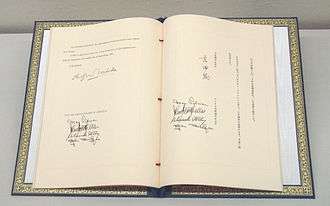Security Treaty Between the United States and Japan

The Security Treaty Between the United States and Japan (日本国とアメリカ合衆国との間の安全保障条約 Nipponkoku to Amerikagasshūkoku to no aida no anzen hoshōjōyaku), was signed on 8 September 1951 in San Francisco, California between representatives of the United States and Japan.
The agreement contained five articles, which dictated that Japan grant the United States the territorial means for it to establish a military presence in the Far East. Moreover, the accord stated that Japan be prohibited from providing foreign powers any bases or any military-related rights without the consent of the United States. The accord was ratified by the United States Senate on 20 March 1952 and then it was signed into U.S. law by the President of the United States on 15 April 1952. Ultimately, the treaty went into effect on 28 April 1952.[1]
Text
Introduction
Japan has this day signed a Treaty of Peace with the Allied Powers. On the coming into force of that Treaty, Japan will not have the effective means to exercise its inherent right of self-defense because it has been disarmed.
There is danger to Japan in this situation because irresponsible militarism has not yet been driven from the world. Therefore, Japan desires a Security Treaty with the United States of America to come into force simultaneously with the Treaty of Peace between the United States of America and Japan.
The Treaty of Peace recognizes that Japan as a sovereign nation has the right to enter into collective security arrangements, and further, the Charter of the United Nations recognizes that all nations possess an inherent right of individual and collective self-defense.
In exercise of these rights, Japan desires, as a provisional arrangement for its defense, that the United States of America should maintain armed forces of its own in and about Japan so as to deter armed attack upon Japan.
The United States of America, in the interest of peace and security, is presently willing to maintain certain of its armed forces in and about Japan, in the expectation, however, that Japan will itself increasingly assume responsibility for its own defense against direct and indirect aggression, always avoiding any armament which could be an offensive threat or serve other than to promote peace and security in accordance with the purposes and principles of the United Nations Charter.
Accordingly, the two countries have agreed as follows:
Article I
Japan grants, and the United States of America accepts, the right, upon the coming into force of the Treaty of Peace and of this Treaty, to dispose United States land, air and sea forces in and about Japan. Such forces may be utilized to contribute to the maintenance of international peace and security in the Far East and to the security of Japan against armed attack from without, including assistance given at the express request of the Japanese Government to put down largescale internal riots and disturbances in Japan, caused through instigation or intervention by an outside power or powers.
Article II
During the exercise of the right referred to in Article I, Japan will not grant, without the prior consent of the United States of America, any bases or any rights, powers or authority whatsoever, in or relating to bases or the right of garrison or of maneuver, or transit of ground, air or naval forces to any third power.
Article III
The conditions which shall govern the disposition of armed forces of the United States of America in and about Japan shall be determined by administrative agreements between the two Governments.
Article IV
This Treaty shall expire whenever in the opinion of the Governments of the United States of America and Japan there shall have come into force such United Nations arrangements or such alternative individual or collective security dispositions as will satisfactorily provide for the maintenance by the United Nations or otherwise of international peace and security in the Japan Area.
Article V
This Treaty shall be ratified by the United States of America and Japan and will come into force when instruments of ratification thereof have been exchanged by them at Washington.
Signatories
IN WITNESS WHEREOF the undersigned Plenipotentiaries have signed this Treaty.
DONE in duplicate at the city of San Francisco, in the English and Japanese languages, this eighth day of September, 1951.
See also
- Treaty of Mutual Cooperation and Security between the United States and Japan
- The second US-Japan alliance treaty, since 1960 to present.
- Supreme Commander for the Allied Powers
- Japan under Allied occupation, from 1945 until 1952.
References
Sources
Further reading
- Hughes, Christopher W. Japan's Security Agenda: Military, Economic, and Environmental Dimensions. Lynne Rienner Publishers, 2004. ISBN 1-58826-260-X